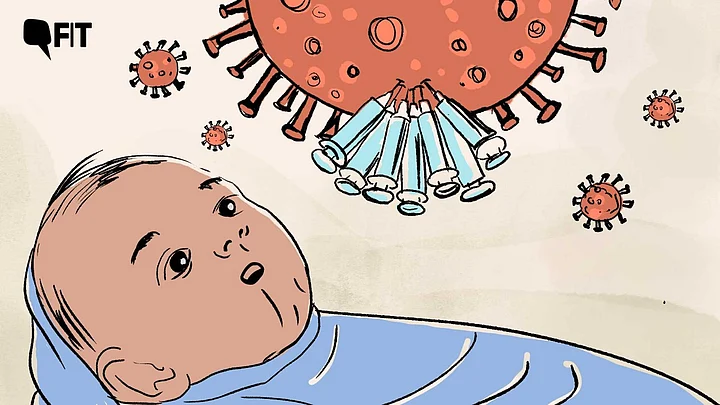On Thursday, 21 July, the US reported its first case of Polio in almost a decade.
Polio is a highly contagious viral infection that was nearly eradicated thanks to robust inoculation efforts the world over. India achieved the 'polio free' status in 2014.
The case in the US may just be a one-off case, but if figures released by the United Nations Children's Fund (UNICEF) recently are anything to go by, the world may be staring at a possible child health crisis from preventable diseases thanks to the drastic fall in essential childhood vaccinations during the pandemic years.
According to the UNICEF, 25 million children missed out on doses of diphtheria, tetanus and pertussis (DTP) shots in 2021, calling it the 'largest backslide in childhood vaccination in a generation'.
"I want to get across the urgency...this is a child health crisis."UNICEF's senior immunisation specialist, Niklas Danielsson as quotes by Reuters.
Measles, and the Resurgence of ‘Eradicated’ Illnesses
What are the implications of missed vaccine doses?
A drop in essential childhood vaccinations can swell the number of people susceptible to dangerous but preventable illnesses like measles, polio, and HPV.
Take the curious case of measles resurgence, for instance.
Measles, a highly contagious viral infection, was rampant before the advent of the measles vaccine in 1963.
Decades of robust vaccine drives later, the illness was declared eliminated from the United States in 2000.
However, due to a combination of reasons including but not restricted to misinformation, and vaccine hesitancy, measles outbreaks among kids started mushrooming in pockets in different US states.
Between January and August 2019 alone, 1215 cases of measles were confirmed by the Centers for Disease Control and Prevention (CDC) — the largest annual tally since 2000.
It's not just the US. Measles is back with a vengeance across the world.
According to the WHO, by November 2019, the global caseload of measles was the highest recorded since 2006, and three times higher than it was in 2018.
The reason for the resurgence is primarily missed vaccination doses.
Speaking of this phenomenon, epidemiologist and public health expert Dr Chandrakant Lahariya tells FIT, "increase in measles in some countries aligns with the reduced coverage in those countries, and we know that if vaccination coverage is lower for a longer period, then the susceptible population – the pool of those who were not vaccinated – goes up, and then a rapid transmission in cases happen, and that's basically what we are seeing."
"There is a theory that if the susceptible pool becomes greater than the pool you are vaccinating, it can result in an outbreak."Dr Chandrakant Lahariya
"This is a broader principle, not an absolute principle," he adds.
The WHO says that for a country to be safe from measles, 95 percent of the population must be immune.
For perspective, India has only hit the 95 percent coverage mark once in 2019. Since then, the number has dropped to 89 percent in 2021.
Can low coverage lead to mutations and new strains, like we saw with COVID?
It will depend on which virus it is, says Dr Lahariya.
"Measles virus is a fairly stable virus and doesn't change. Low coverage of measles vaccine leads to those susceptible going up."Dr Chandrakant Lahariya
The situation is bad overall, with the global rate of childhood vaccination being lower last year than it was in the last thirty years, but let's take a closer look at how India's doing.
The Situation in India: What Data Says
The uptake of DTP3 (the third dose of the diphtheria, pertussis, and tetanus combination vaccine) , the vaccine that the UNICEF uses as a marker for a country's vaccination, fell sharply from 91 percent in 2019 to 85 percent in 2021.
Only 85 percent of eligible children received the third dose of the polio vaccine in 2021, as opposed to the 91 percent that got it in 2019.
The MCV1 – measles vaccine – too saw a sharp fall in uptake, from 95 percent in 2019 to 89 percent in 2021.
(Data Source: UN)
‘India Can Achieve Better Vaccine Coverage'
Speaking to FIT, epidemiologist and public health expert, Dr Chandrakant Lahariya says India's falling vaccination rates are not entirely shocking.
"If we juxtaposed this information with that of childhood vaccination, India has never achieved (overall) 80 percent of childhood vaccination, while even our neighbouring nations of Nepal, Bangladesh and Sri Lanka have consistently achieved 95 percent upwards of full vaccination."Dr Chandrakant Lahariya, Epidemiologist, Public Health Expert
However, Dr Lahariya believes that India is capable of upping these numbers. Just look at the success of the national COVID-19 inoculation drive for inspiration.
"COVID-19 is a reminder that if they desire, governments can achieve high vaccination coverage," he says.
"The long term policy response ought to be to widen the ambit of the government health care system and to strengthen it in terms of human resources, technical resources (and funding!)," says Dr Satyajit Rath, Immunologist, National Institute of Immunology to FIT.

